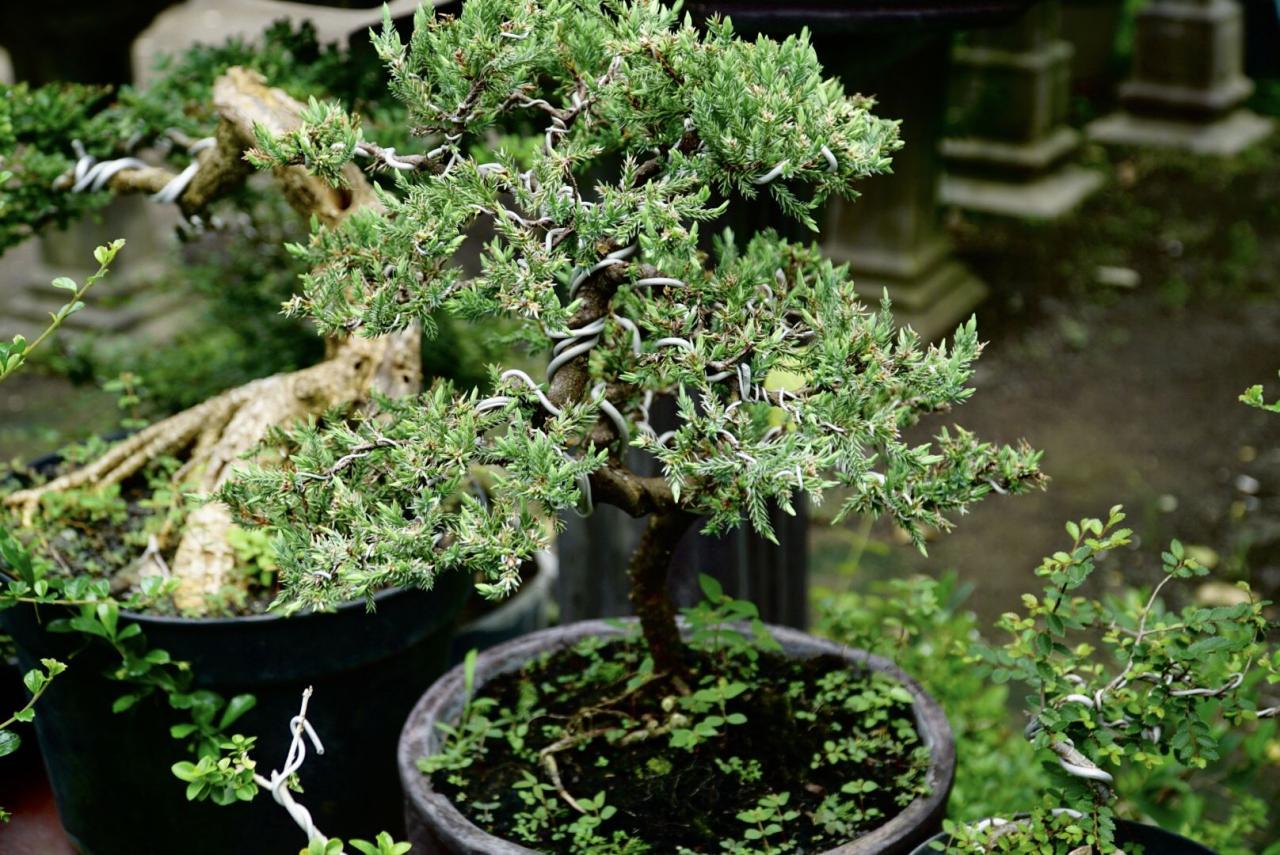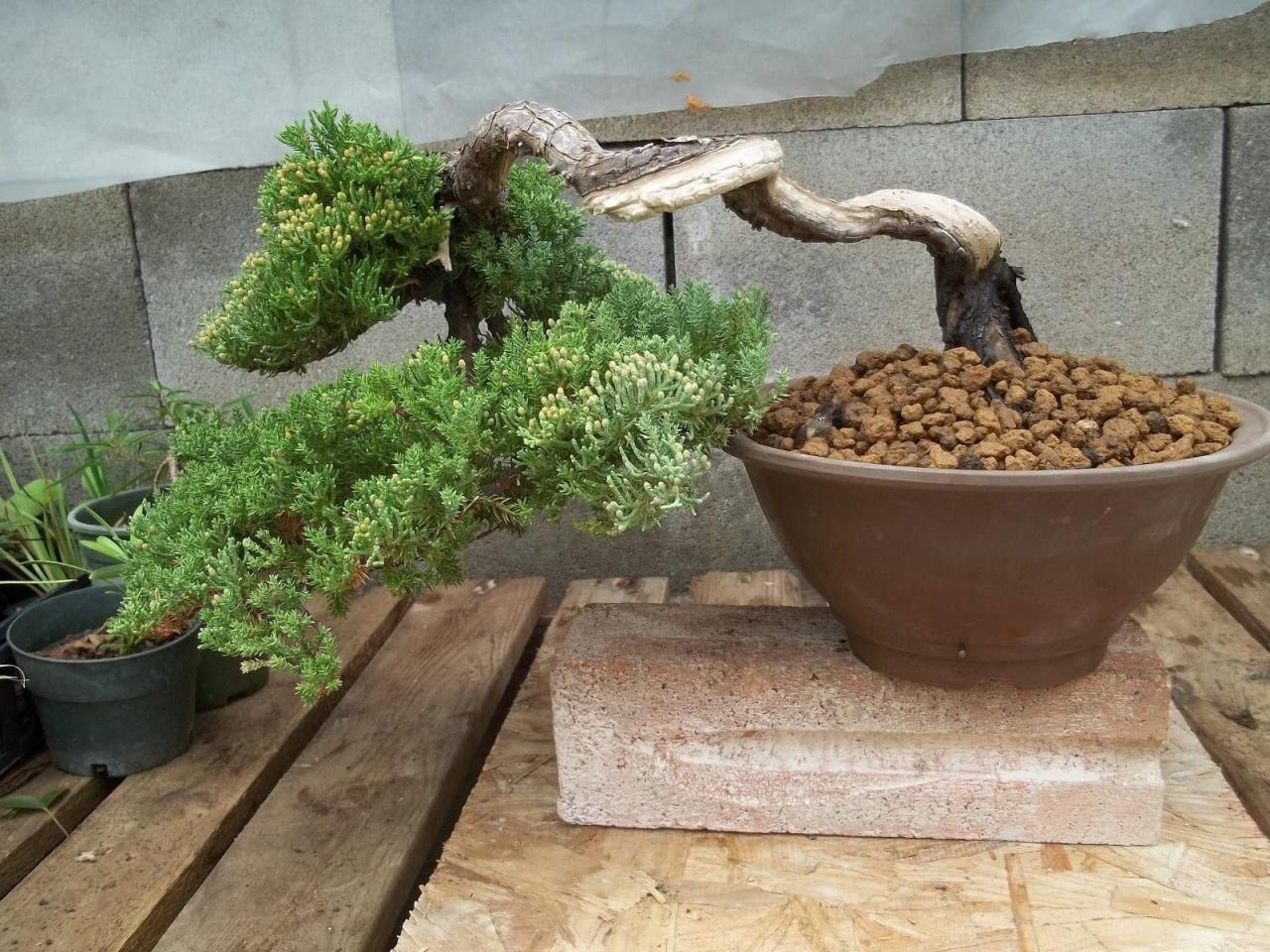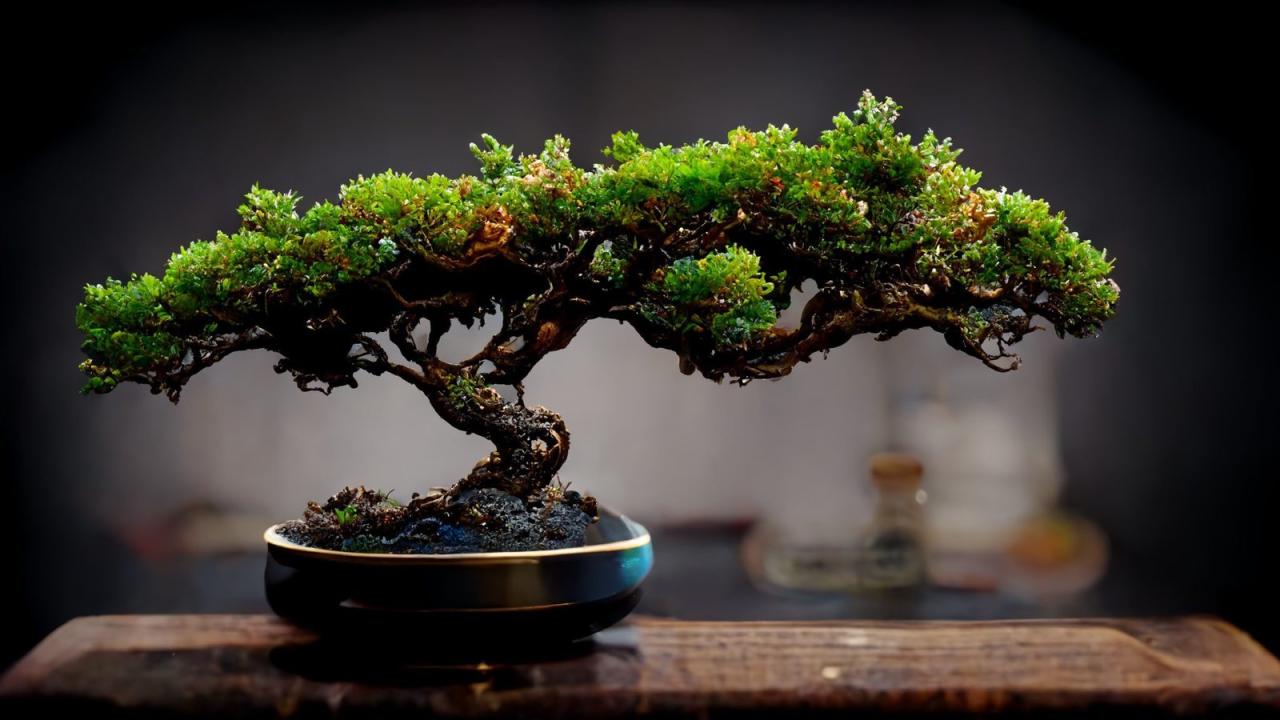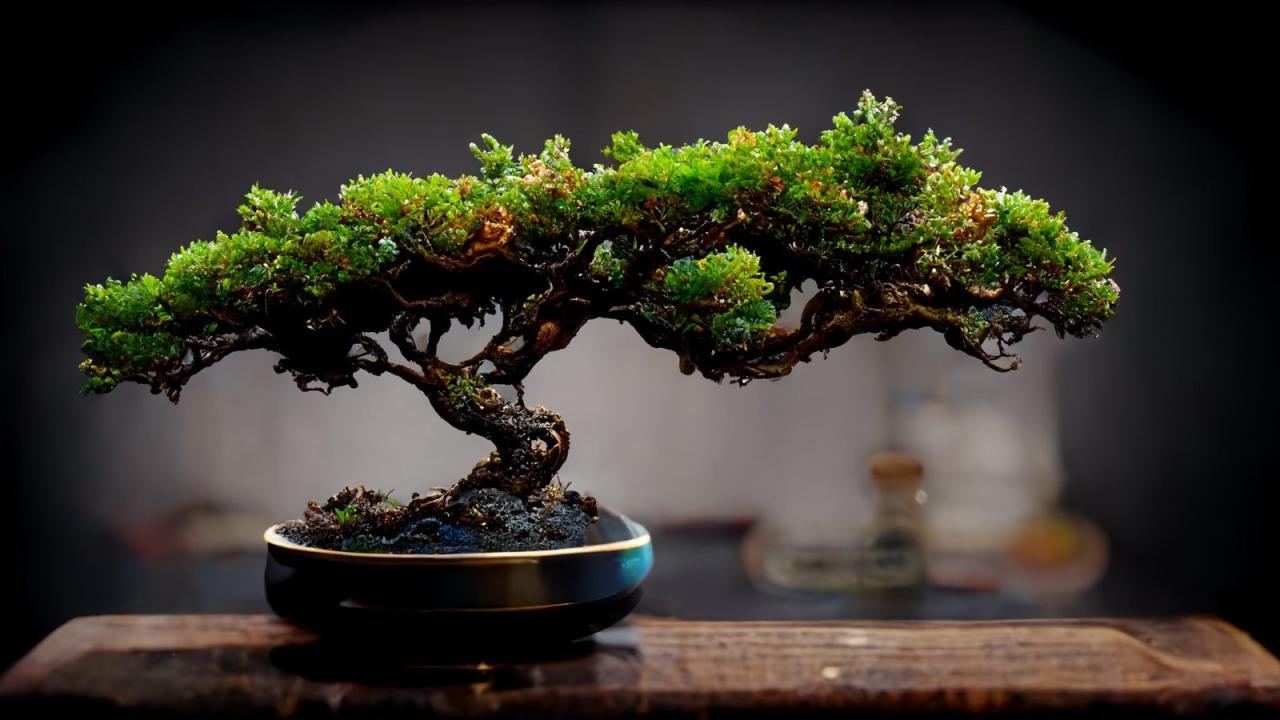How To Care For Juniper Bonsai Indoors: Juniper bonsai, with their rugged beauty and captivating miniature landscapes, are a popular choice for indoor cultivation. However, bringing these hardy trees indoors presents unique challenges that require careful consideration. Understanding the specific needs of juniper bonsai, from light and watering to temperature and humidity, is essential for ensuring their continued health and growth.
This comprehensive guide will delve into the essential aspects of caring for juniper bonsai indoors, providing insights and practical tips to help you cultivate these miniature marvels in your home. From selecting the right light conditions to mastering pruning techniques, this guide will equip you with the knowledge to create a thriving bonsai oasis within your living space.
Introduction
Juniper bonsai, with their rugged beauty and resilient nature, offer a captivating challenge for indoor cultivation. These miniature evergreen trees, known for their distinctive foliage and intricate branch structures, bring a touch of the outdoors into your home. Juniper bonsai are prized for their adaptability and hardiness, making them a popular choice for both seasoned bonsai enthusiasts and beginners.
However, growing juniper bonsai indoors presents unique challenges that require careful attention and understanding.
The Appeal of Juniper Bonsai for Indoor Cultivation
Juniper bonsai are particularly well-suited for indoor cultivation due to their tolerance for a wide range of light conditions and their ability to thrive in containers. Their evergreen foliage provides year-round visual interest, adding a touch of natural beauty to any indoor space.
- Adaptability:Juniper bonsai can tolerate a range of light conditions, from bright indirect light to partial shade, making them suitable for various indoor locations.
- Hardiness:Juniper bonsai are known for their resilience and ability to withstand a degree of neglect, making them relatively easy to care for indoors.
- Aesthetic Appeal:Their rugged beauty, distinctive foliage, and intricate branch structures make them visually captivating and add a touch of nature to indoor spaces.
Characteristics of Juniper Bonsai
Juniper bonsai belong to the Juniperus genus, which encompasses a wide variety of evergreen trees and shrubs. They are characterized by their needle-like or scale-like foliage, which can vary in color from deep green to blue-green or even golden.
- Foliage:Juniper bonsai have needle-like or scale-like foliage, depending on the species. The foliage color can range from deep green to blue-green or even golden.
- Branch Structure:Their branches are typically sturdy and have a distinctive, often gnarled or twisted appearance, adding to their visual appeal.
- Growth Habit:Juniper bonsai are typically slow-growing, making them suitable for long-term indoor cultivation.
Challenges of Growing Juniper Bonsai Indoors
While juniper bonsai are relatively adaptable, growing them indoors presents unique challenges. The controlled environment of an indoor space can affect their growth and development, requiring careful attention to factors such as light, humidity, and temperature.
- Light:Providing adequate light is crucial for the health and growth of juniper bonsai. Indoor light levels can be insufficient, leading to etiolation (weak, elongated growth) and a decline in overall health.
- Humidity:Juniper bonsai prefer moderate humidity levels. Indoor air can be quite dry, especially during winter, which can lead to leaf drop and other problems.
- Temperature:Juniper bonsai are adapted to cool temperatures and can be sensitive to extreme heat or cold. Indoor temperatures can fluctuate, requiring careful monitoring and adjustment to ensure optimal growth.
Light Requirements
Juniper bonsai, like most plants, thrive in ample sunlight. Understanding their light needs is crucial for their growth and health. Providing the right amount of light ensures they produce vibrant foliage, maintain their shape, and avoid disease.
Natural Sunlight vs. Artificial Light
Natural sunlight is the ideal light source for juniper bonsai. It provides the full spectrum of light that these plants need for photosynthesis. However, indoor conditions often limit access to direct sunlight. Artificial light sources can be a viable alternative, but they must be carefully chosen and used correctly.
- Natural Sunlight:
- Direct sunlight for a few hours daily is ideal for most juniper bonsai.
- South-facing windows offer the most sunlight, followed by west-facing windows.
- During summer months, protect your bonsai from excessive heat by providing shade during the hottest part of the day.
- Observe the foliage for signs of sunburn, such as browning or wilting, and adjust accordingly.
- Artificial Light:
- Full-spectrum fluorescent bulbs or LED grow lights are good options for supplementing natural light.
- Place the light source 12-18 inches above the bonsai.
- Provide at least 12-14 hours of light per day, mimicking natural daylight hours.
- Monitor the bonsai’s growth and adjust the light source as needed.
Importance of Proper Light Exposure
Adequate light exposure is vital for the health and well-being of juniper bonsai.
- Photosynthesis:Light fuels photosynthesis, the process by which plants convert light energy into chemical energy for growth. Without sufficient light, bonsai will struggle to produce new growth and maintain their vibrant foliage.
- Branch Development:Proper light exposure promotes strong branch development and a compact, dense shape. Without enough light, branches may become weak and spindly.
- Disease Resistance:Healthy bonsai are better equipped to resist diseases and pests. Insufficient light can weaken the plant’s immune system, making it more susceptible to problems.
Watering Techniques
Proper watering is crucial for the health and longevity of your juniper bonsai. Overwatering and underwatering can both lead to serious problems, so it’s important to strike a balance.
Assessing Soil Moisture Levels
To determine when your juniper bonsai needs watering, you need to assess the moisture level of the soil.
- Visual Inspection:Look at the top layer of soil. If it appears dry and crumbly, it’s likely time to water.
- Finger Test:Stick your finger about an inch into the soil. If it feels dry, it’s time to water. If it feels slightly moist, you can wait a bit longer.
- Weight Test:Lift the bonsai pot. If it feels light, the soil is likely dry. If it feels heavy, the soil is likely still moist.
Soil and Potting

The soil composition and pot selection play a crucial role in the health and well-being of your indoor juniper bonsai. Choosing the right soil and pot ensures proper drainage, aeration, and nutrient availability, fostering optimal growth and minimizing the risk of root rot.
Soil Composition
The ideal soil mix for indoor juniper bonsai should be well-draining, allowing excess water to escape readily. This prevents waterlogging, which can lead to root rot and other problems. A typical soil mix for juniper bonsai includes:
- Akadama:A volcanic clay soil that provides excellent drainage and aeration, and retains moisture. It is the most common soil used for bonsai, especially for conifers like junipers.
- Kanuma:Another volcanic clay soil, but with a finer texture than Akadama. It retains moisture better and is suitable for young or delicate bonsai.
- Pumice:A lightweight, porous volcanic rock that improves drainage and aeration, preventing compaction.
- Grit:A coarse, inorganic material like gravel or sand that further enhances drainage and aeration.
The proportions of these ingredients can vary depending on the specific needs of your juniper bonsai and the climate you live in. For example, a mix of 70% Akadama, 20% Kanuma, and 10% Pumice can be suitable for most indoor juniper bonsai.
Benefits of Well-Draining Soil
Well-draining soil is essential for the health of your juniper bonsai because it:
- Prevents root rot:Excess water in the soil can suffocate the roots, leading to root rot, a serious condition that can kill your bonsai.
- Promotes root aeration:Well-draining soil allows air to circulate around the roots, promoting healthy root growth.
- Ensures nutrient availability:When water drains properly, nutrients in the soil are more readily available to the roots.
Pot Size and Drainage
The pot size and drainage are critical factors in maintaining a healthy indoor juniper bonsai.
- Pot size:The pot should be slightly larger than the root ball, allowing for future growth. A pot that is too large can lead to waterlogging and root problems, while a pot that is too small can restrict root growth and limit the bonsai’s overall health.
- Drainage:The pot should have drainage holes at the bottom to allow excess water to escape. A drainage tray beneath the pot can collect excess water, preventing it from pooling around the roots.
It’s important to choose a pot made of a material that is suitable for bonsai, such as glazed ceramic, unglazed ceramic, or plastic. These materials are porous, allowing for proper aeration and drainage.
Temperature and Humidity
Juniper bonsai, like most other bonsai trees, thrive in specific temperature and humidity ranges. Understanding these requirements is crucial for replicating their natural environment and ensuring their optimal growth and health.
Ideal Temperature Range
Juniper bonsai prefer moderate temperatures, similar to their natural habitats. The ideal temperature range for indoor juniper bonsai is between 65°F (18°C) and 75°F (24°C). These temperatures promote healthy growth and prevent stress.
Humidity and Its Impact
Humidity plays a vital role in the health and well-being of juniper bonsai. These trees are native to areas with moderate to high humidity levels. Dry indoor air can lead to several issues:
- Leaf drop:Low humidity can cause leaves to dry out and fall off.
- Stunted growth:Lack of humidity can hinder the tree’s ability to absorb nutrients and water efficiently, resulting in stunted growth.
- Pest infestation:Dry conditions can make the tree more susceptible to pest infestations, as pests thrive in dry environments.
Managing Humidity Levels, How To Care For Juniper Bonsai Indoors
Maintaining adequate humidity levels is essential for indoor juniper bonsai. Several techniques can be employed to create a more humid environment:
- Humidifier:Using a humidifier is the most effective way to increase humidity levels. Choose a humidifier that is appropriate for the size of your space and can maintain a humidity level between 40% and 60%.
- Pebble tray:Fill a shallow tray with pebbles and water. Place the bonsai pot on top of the pebbles, ensuring the pot’s base is not submerged in water. As the water evaporates, it will increase humidity around the tree.
- Grouping plants:Placing multiple plants together can create a microclimate with higher humidity. The plants will naturally release moisture into the air, increasing the overall humidity levels.
- Misting:Misting the tree regularly can temporarily increase humidity. However, be cautious not to over-mist, as it can lead to fungal growth.
Pruning and Shaping
Pruning is an essential aspect of juniper bonsai care, allowing you to control its size, shape, and overall aesthetic appeal. Regular pruning helps maintain the desired style and encourages new growth, leading to a more compact and aesthetically pleasing bonsai.
Pruning Techniques
Different pruning techniques are employed depending on the desired effect and the stage of growth of the juniper bonsai.
- Pinching:This technique involves removing the growing tips of new shoots, promoting bushier growth and a denser canopy. Pinching is typically performed throughout the growing season to maintain the shape and control the growth rate.
- Cutting:Cutting involves removing larger branches using sharp pruning shears or a bonsai saw. This technique is used to reshape the bonsai, remove dead or diseased branches, and create specific branch structures.
- Wiring:Wiring involves using aluminum or copper wire to bend and shape branches. It’s essential to use wire with a diameter appropriate for the branch size and to remove the wire once the branch has set in the desired position.
Wiring is typically done during the dormant season to minimize damage to the bark.
Maintaining the Desired Shape and Size
Maintaining the desired shape and size of your juniper bonsai involves regular pruning and shaping.
Caring for a juniper bonsai indoors requires a bit more attention than some other species. You’ll need to provide the right amount of light, water, and humidity to keep your tree healthy and thriving. For a comprehensive guide to the basics of bonsai care, check out this article on Bonsai Tree Care for Beginners: What to Know.
Once you’ve mastered the fundamentals, you can move on to more specific techniques for juniper bonsai, such as pruning and shaping.
- Regular Pruning:Pruning should be done regularly throughout the growing season, focusing on removing any new growth that deviates from the desired shape. This helps maintain the bonsai’s overall form and promotes a balanced growth pattern.
- Selective Pruning:Pruning should be selective, removing only the necessary branches to maintain the bonsai’s aesthetic appeal. Avoid removing too much foliage at once, as this can stress the tree.
- Seasonal Considerations:Pruning should be adjusted according to the season. During the active growing season, focus on pinching and trimming to maintain the shape. In the dormant season, more significant pruning, including cutting and wiring, can be performed.
Repotting and Root Care
Repotting is a crucial aspect of juniper bonsai care, as it allows for the renewal of the potting medium, promotes healthy root growth, and provides an opportunity to adjust the bonsai’s shape and style.
Repotting Frequency
The frequency of repotting depends on the age and health of the juniper bonsai. Young, actively growing trees typically require repotting every 1-2 years, while mature trees may only need repotting every 3-5 years. Signs that indicate the need for repotting include roots circling the inside of the pot, poor drainage, and stunted growth.
Repotting Process
Repotting a juniper bonsai involves carefully removing the tree from its current pot, pruning the roots, and planting it in a new pot with fresh potting medium. Here’s a step-by-step guide:
Preparing the New Pot
- Choose a pot that is slightly larger than the previous pot, allowing for healthy root growth.
- Ensure the new pot has drainage holes to prevent waterlogging.
- Place a layer of drainage material, such as gravel or pebbles, at the bottom of the pot.
- Add a layer of potting mix, leaving enough space for the root ball.
Removing the Bonsai from the Pot
- Gently tap the bottom of the pot to loosen the root ball.
- If the bonsai is still stuck, use a tool like a bonsai knife to carefully pry the root ball from the pot.
Root Pruning
- Remove any circling or dead roots. This encourages the development of a healthy, fibrous root system.
- Use sharp, sterilized pruning shears to make clean cuts.
- Prune the roots by about 1/3 to 1/2, depending on the health of the root system.
Planting the Bonsai
- Place the bonsai in the new pot, ensuring that the trunk is centered and at the desired height.
- Add potting mix around the root ball, gently pressing it down to secure the bonsai.
- Water thoroughly to settle the soil and ensure proper hydration.
Maintaining Healthy Root Systems
- Proper Watering:Water consistently, allowing the soil to dry slightly between waterings. Overwatering can lead to root rot, while underwatering can stress the tree.
- Good Drainage:Ensure the pot has adequate drainage holes to prevent waterlogging. This allows excess water to drain away, preventing root problems.
- Appropriate Potting Mix:Use a well-draining potting mix designed for bonsai, containing ingredients like akadama, pumice, or lava rock. This allows for proper aeration and drainage.
- Fertilization:Regularly fertilize the juniper bonsai during the growing season with a balanced bonsai fertilizer to provide essential nutrients for healthy root growth.
Common Pests and Diseases: How To Care For Juniper Bonsai Indoors
While juniper bonsai are generally resilient, they can be susceptible to various pests and diseases, especially when grown indoors. Early detection and timely intervention are crucial for maintaining the health and vitality of your bonsai.
Identifying Common Pests
Identifying common pests is the first step towards effective treatment.
- Spider mites:These tiny pests spin webs on the underside of leaves, causing yellowing and stippling. They thrive in dry conditions.
- Aphids:These sap-sucking insects cluster on the undersides of leaves and stems, causing leaf distortion and wilting.
- Scale insects:These armored pests attach themselves to stems and branches, sucking sap and leaving behind a sticky residue.
- Mealybugs:These white, cottony insects are often found in leaf axils and on stems, feeding on plant sap.
Preventing and Treating Pests
- Regular inspection:Regularly inspect your juniper bonsai for signs of pests, such as webbing, sticky residue, or discolored leaves. Early detection is key to successful treatment.
- Isolation:If you suspect a pest infestation, isolate the bonsai from other plants to prevent spreading.
- Horticultural oil:A diluted horticultural oil spray can effectively control pests like aphids, mealybugs, and spider mites. Apply it according to the product instructions.
- Insecticidal soap:Another effective option for controlling pests is insecticidal soap, which disrupts the insect’s outer layer.
- Beneficial insects:Introducing beneficial insects, such as ladybugs or lacewings, can help control pest populations naturally.
Identifying Common Diseases
- Root rot:This fungal disease occurs when the soil is constantly wet, leading to root decay and wilting.
- Blight:This fungal disease can cause browning and needle drop. It thrives in humid conditions.
- Rust:This fungal disease causes orange or brown pustules on needles and stems. It can spread quickly.
Preventing and Treating Diseases
- Proper watering:Ensure the soil dries slightly between waterings to prevent root rot.
- Good air circulation:Ensure good air circulation around the bonsai to prevent fungal diseases.
- Fungicides:Apply a fungicide to treat fungal diseases like blight and rust.
Winter Care

Juniper bonsai, like most other bonsai trees, require special care during the winter months to ensure their survival and continued health. Winter brings about a period of dormancy for juniper bonsai, and understanding their needs during this time is crucial for their well-being.
Watering Adjustments
During winter, juniper bonsai trees enter a period of dormancy, which means their growth slows down significantly. This also affects their water requirements. The cold temperatures slow down the rate of transpiration, which is the process of water loss through leaves.
As a result, juniper bonsai need less frequent watering during winter compared to the warmer months.
- Check the soil moisture before watering:The best way to determine if your juniper bonsai needs water is to check the soil moisture. Insert your finger about an inch into the soil. If the soil feels dry, then water your bonsai. If it feels moist, wait a few more days before checking again.
- Water thoroughly when necessary:When you do water your juniper bonsai during winter, ensure that you water it thoroughly, allowing the water to drain out of the drainage holes in the pot. This ensures that the roots are properly hydrated.
- Avoid overwatering:Overwatering is a common problem during winter, as the cold temperatures can slow down the rate of water absorption by the roots. Overwatering can lead to root rot, which can be fatal to your juniper bonsai.
Temperature and Frost Protection
Juniper bonsai are generally hardy trees and can tolerate some cold temperatures. However, it is important to protect them from extreme cold and frost, as this can damage the delicate needles and branches.
- Ideal temperature range:The ideal temperature range for juniper bonsai during winter is between 35°F and 50°F (1.5°C and 10°C).
- Protect from freezing temperatures:If the temperature drops below freezing, it is essential to protect your juniper bonsai from frost. You can do this by bringing your bonsai indoors, placing it in a garage, or covering it with a frost blanket.
- Avoid sudden temperature changes:Avoid sudden temperature changes, as this can shock the bonsai and damage its needles. If you are bringing your bonsai indoors from the cold, allow it to acclimate to the warmer temperature gradually.
Light Requirements
While juniper bonsai are known for their tolerance to different light conditions, their light requirements change during winter. As the days shorten and the sun’s intensity weakens, juniper bonsai require less light.
Caring for a juniper bonsai indoors requires careful attention to its unique needs. While these hardy trees can thrive in a variety of conditions, providing them with the right environment is crucial for their long-term health. For a comprehensive guide on maintaining a healthy bonsai tree, consult How to Maintain a Healthy Bonsai Tree: Expert Tips.
This resource will provide valuable insights into essential aspects like watering, fertilizing, and pruning, which are vital for the well-being of your juniper bonsai.
- Provide bright, indirect light:During winter, provide your juniper bonsai with bright, indirect light. Avoid placing it in direct sunlight, as this can scorch the needles. A south-facing window with a sheer curtain or a bright, well-lit room can provide the necessary light conditions.
- Consider supplemental lighting:In areas with limited sunlight, you may consider using supplemental lighting to provide additional light for your juniper bonsai. Fluorescent or LED grow lights are good options for providing supplemental light.
Winter Pruning
While general pruning is best done during the growing season, there are specific winter pruning practices that can be beneficial for juniper bonsai.
- Deadwood removal:Winter is an ideal time to remove any dead or damaged branches. This helps to maintain the health of the bonsai and prevent the spread of disease.
- Minimal shaping:Avoid significant shaping or pruning during winter. The bonsai is dormant, and any major pruning can stress the tree.
Epilogue

Caring for juniper bonsai indoors is a rewarding journey that allows you to connect with nature’s artistry on a smaller scale. By understanding their specific needs and providing them with the proper care, you can nurture these resilient trees into miniature masterpieces.
Remember, patience and attention to detail are key to cultivating a thriving juniper bonsai indoors. With dedication and the right approach, you can enjoy the beauty and serenity of these miniature landscapes for years to come.
Quick FAQs
What is the best time of year to repot a juniper bonsai?
The best time to repot a juniper bonsai is in the spring or early summer, after the tree has begun to actively grow. This allows the tree time to recover from the repotting process and establish new roots before the cooler temperatures of fall and winter arrive.
Can I use tap water to water my juniper bonsai?
While tap water is generally safe for watering bonsai, it’s best to avoid using water that is heavily chlorinated or contains high levels of minerals. If possible, let tap water sit for 24 hours before using it to allow the chlorine to dissipate.
You can also consider using rainwater or distilled water for best results.
How often should I fertilize my juniper bonsai?
The frequency of fertilization for juniper bonsai depends on the season and the tree’s growth rate. During the active growing season (spring and summer), fertilize every 2-4 weeks with a balanced bonsai fertilizer. Reduce fertilization to once a month during the cooler months (fall and winter).
